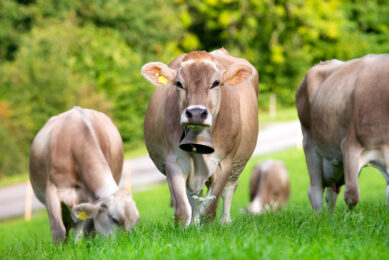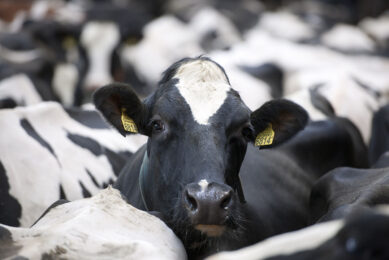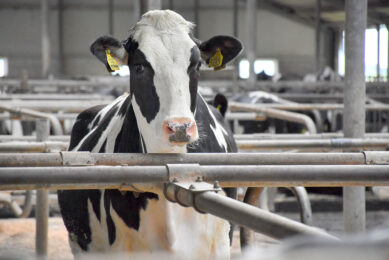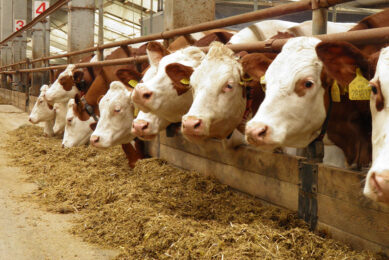Aiming for a seamless transition period
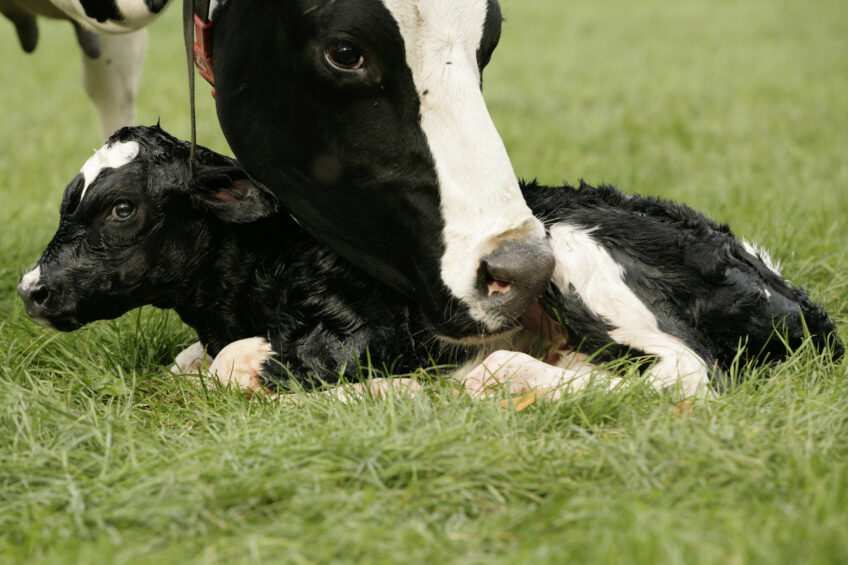
Controlling energy consumption during the dry cow period through the incorporation of low energy ingredients such as straw, oat hulls or poor-quality hay has been shown to improve transition cow health.
Over-feeding energy during the dry period has resulted in reduced performance and higher incidences of metabolic disorders such as:
- Lower fresh cow dry matter intake (DMI) and slower starts in milk production (Douglas et al., 2006; Dann et al., 2006)
- Higher NEFA (non-esterified fatty acids) in blood and more triglyceride in the liver after calving (Douglas et al., 2006; Janovick Guretzky et al., 2006)
- Greater deposition of fat in the dry cow with moderate overfeeding of non-lactating cows for 57 days leads to increase in visceral adipose tissues (omental, mesenteric, and perirenal) than in cows fed a high-straw diet to control energy intake at requirements (Nikkhah et al., 2009)
- Decreased neutrophil function postpartum. Controlled energy intake during the dry period (Graugnard et al., 2008) improved neutrophil function which may lead to better immune function.

Controlling bodyweight and condition
Many dairy producers have adopted the controlled energy diet with a 1-group dry cow feeding scenario. The success of this programme is largely related to controlling body weight gain and condition through the far-off period. But the other consideration is the potential for increased DMI throughout the dry cow period and the resultant impact on fresh cow DMI. Researchers at Ohio State University (Richards et al. 2009) completed an experiment designed to determine whether moving dry cows to a higher-energy close-up diet at 3 weeks before calving would be beneficial to cows during the transition compared with a single high-bulk diet fed all the way through to calving. The cows in the 1-group dry cow diet had the least change in DMI after calving and lower concentration of fat in the liver as compared to the cows fed a far-off and close-up diet. The researchers concluded that there was little evidence that the 2-group strategy offered any advantage compared with the single-diet (controlled energy high-fibre) strategy.
Optimising DMI in fresh cows
The potential “stumbling block” for the 1-group feeding strategy is the marked difference in the pre-fresh and post-fresh diets. The pre-fresh diet is bulky and low energy while the post-fresh tends to be a denser, higher energy diet with shorter material. Improving the transition between these 2 diets and optimising DMI in the fresh period is critical for success.
Penner et al., 2007 examined the incidence of sub-acute ruminal acidosis (SARA) in primiparous fresh cows fed a close-up diet, followed by a lactation diet that containing adequate physically effective fibre (peNDF). The study concluded that there was a high prevalence rate of SARA in primiparous animals (Figure 1).
Reducing the particle size
SARA in the fresh cow is associated with a remarkable change in diet from the close-up to the fresh cow and the inclusion of highly fermentable carbohydrates in the lactating diet. The other area to consider is the remarkable change in DMI from the dry period to the fresh period. The rapid increase in DMI after calving may overwhelm the rumen environment with a marked increase in volatile fatty acids (VFA). This resulting surge in VFAs could lead to an increased incidence of SARA through a rapid reduction in rumen pH. Improving DMI in the dry period should reduce the difference in DMI between the pre-fresh and post-fresh cow.
The strategy to improve DMI pre-fresh is to reduce the particle size of the material (especially the forage component) in the dry cow diet. The particle size of the dry cow TMR will “mimic” the particle size of the lactating TMR. Reducing the particle size of the dry cow TMR will increase passage rate of the material and lead to an increase in DMI. The higher DMI pre-calving will be closer to the expected DMI post-calving – decreasing this gap will improve the transition between the 2 diets. The added benefit of the reduced particle size in the dry cow diet is reduced sorting behaviour – each “bite” represents a homogeneous mix of the ingredients. Using the Penn State Forage Separator (3 compartment), the recommendation would be to have a similar ratio of ingredients on both the lactating and dry cow TMR’s (example: < 10% Top, >45% Middle, < 45% Bottom) Figure 2 shows a real-life example of both a dry cow and lactating TMR using these concepts. The particle size ratios between the dry cow TMR and lactating TMR were very similar but the density (as seen in the image below) were quite different.
Aim for similar densities of the diets
The other area that is under investigation is matching the density (kg/ft3) of the pre-fresh diet with the density of the post-fresh diet. Because of the bulky nature of the chopped straw diet, there may be a noticeable difference in the density (kg/ft3) of the pre-fresh and the post-fresh diet. This can be measured by constructing a cubic foot box and weighing both TMR’s – pre and post-calving. The goal for a seamless transition would be to provide diets that have similar densities. Adding water to the pre-fresh TMR and decreasing particle size will increase the density and reduce sorting behaviour. This will improve DMI of the pre-fresh diet and ensure a smoother transition.

The density (kg/ft3) was determined using a cubic foot box that is filled (without packing) with the dry cow TMR and the lactating cow TMR. The dry cow TMR in this scenario was 4.6 kg AF/ft3 (2.372 kg DM/ft3) and the lactating TMR was 8.6 kg AF/ft3 (3.96 kg DM/ft3).
Recommendations to reduce this difference would be to increase the density of the dry cow ration with the addition of water or by adding bulk to the fresh cow TMR with the addition of chopped dry hay. Research by DeVries et al., 2008 demonstrates that fresh cows will sort for longer fibre length while cows further in lactation sort against fibre length. Ensuring adequate particle size is critical to reduce sorting behaviour and improve the transition.
Conclusion
Working towards a seamless transition by altering the particle size and density of the dry cow TMR is an effective management strategy. Designing a dry cow diet that mimics the physical properties of the lactating diet but is nutritionally designed for the dry cow will improve this delicate transition balance.
Join 13,000+ subscribers
Subscribe to our newsletter to stay updated about all the need-to-know content in the dairy sector, two times a week.



